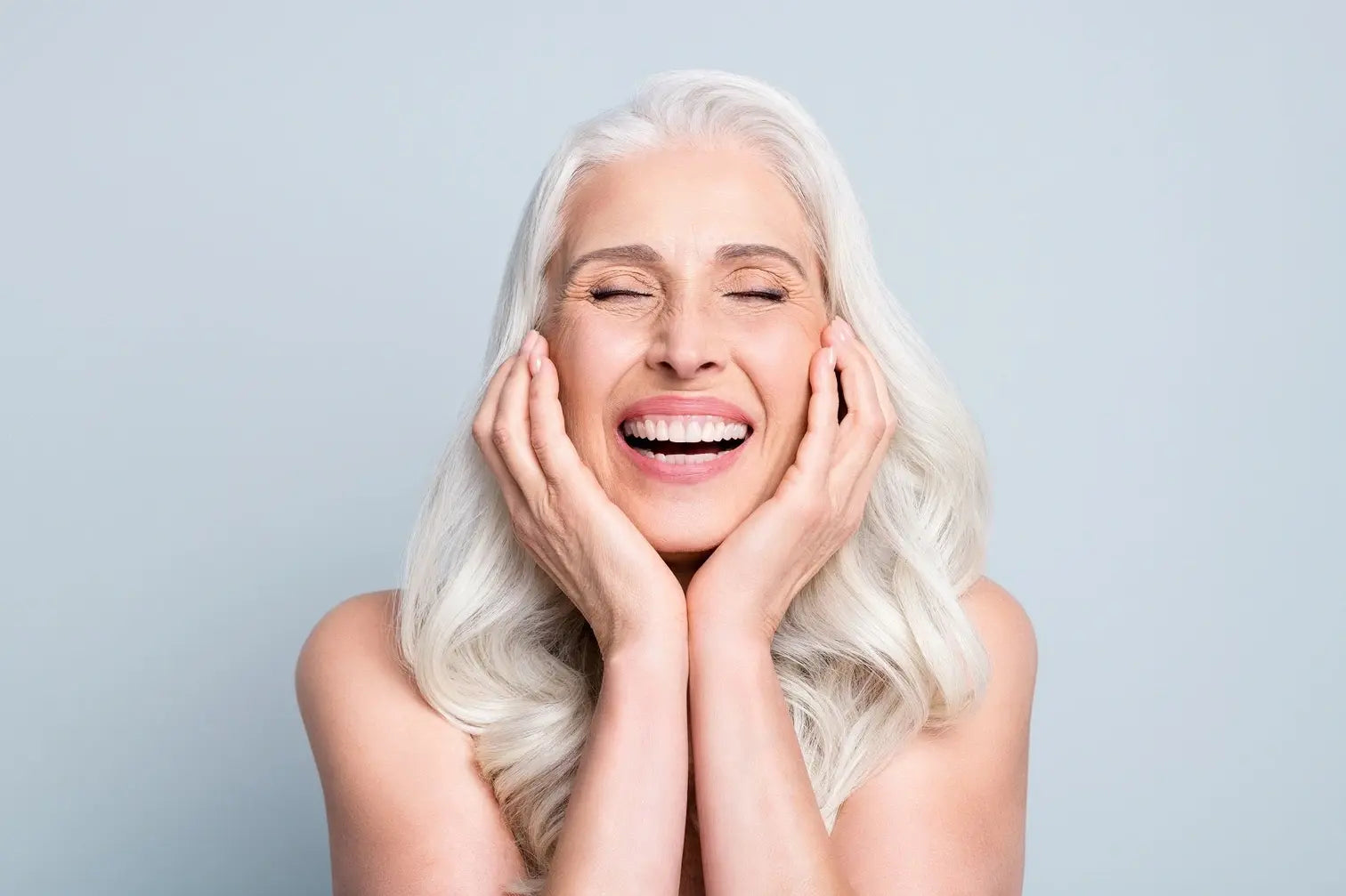Can you repair aged skin? What is the most effective treatment for aging skin?
Can you repair aged skin? What is the most effective treatment for aging skin?
How do you rejuvenate aging skin?
- Establish a consistent skin care routine: By establishing a scientifically-backed skin care regimen, you can promote skin to heal from damage and improve its defenses against further damage that can accelerate the appearance of aging. For those on the go or with inconsistent schedules, our travel-size skin care products offer a convenient solution.
- Changes in diet: Adding different types of healthy vitamins and minerals through diet is an effective way to give your body the nutrition it needs to heal. Some of the best foods for skin repair include fish for omega-3’s, bell peppers for beta carotene, and tomatoes for vitamin C. [4]
- Cleansing: As you may know, the benefits of cleansing your face daily are vast as this step in the process removes dirt, product buildup, and toxins that could accelerate skin damage and may be blocking topically applied beneficial ingredients from reaching the deeper layers of your mature skin. [5]
How do you rejuvenate aging skin?
- Establish a consistent skin care routine: By establishing a scientifically-backed skin care regimen, you can promote skin to heal from damage and improve its defenses against further damage that can accelerate the appearance of aging. For those on the go or with inconsistent schedules, our travel-size skin care products offer a convenient solution.
- Changes in diet: Adding different types of healthy vitamins and minerals through diet is an effective way to give your body the nutrition it needs to heal. Some of the best foods for skin repair include fish for omega-3’s, bell peppers for beta carotene, and tomatoes for vitamin C. [4]
- Cleansing: As you may know, the benefits of cleansing your face daily are vast as this step in the process removes dirt, product buildup, and toxins that could accelerate skin damage and may be blocking topically applied beneficial ingredients from reaching the deeper layers of your mature skin. [5]
What is the best skin care routine for aging skin?
- Sunscreen: Regular use of sunscreen on sun-exposed skin is instrumental in protecting your skin from damage caused by the UV rays of the sun, which cause up to 80% of visible signs of aging. [6]
- Cleanse: Cleansing your skin with a gentle gel cleanser at least once per day will remove built-up debris in order for your skin to fully absorb the ingredients from the rest of your routine. [4]
- Moisturize: Moisturizing the skin is important for maintaining a healthy skin barrier. Better yet, opt for a moisturizer that also contains scientifically and clinicaly validated ingredients proven to improve skin's health and longevity, like OneSkin's Topical Supplements. OS-01 FACE, OS-01 EYE, and OS-01 BODY all contain the scientifically-proven OS-01 peptide and are clinically validated to improve skin's barrier function, hydration, and texture. [1, 2, 3]
What is the best skin care routine for aging skin?
- Sunscreen: Regular use of sunscreen on sun-exposed skin is instrumental in protecting your skin from damage caused by the UV rays of the sun, which cause up to 80% of visible signs of aging. [6]
- Cleanse: Cleansing your skin with a gentle gel cleanser at least once per day will remove built-up debris in order for your skin to fully absorb the ingredients from the rest of your routine. [4]
- Moisturize: Moisturizing the skin is important for maintaining a healthy skin barrier. Better yet, opt for a moisturizer that also contains scientifically and clinicaly validated ingredients proven to improve skin's health and longevity, like OneSkin's Topical Supplements. OS-01 FACE, OS-01 EYE, and OS-01 BODY all contain the scientifically-proven OS-01 peptide and are clinically validated to improve skin's barrier function, hydration, and texture. [1, 2, 3]
What are 4 steps for an aging skin care routine?
What are 4 steps for an aging skin care routine?
- The ideal skin care regimen for aging skin includes cleansing, moisturizing, and using a sunscreen with sufficient SPF. For the best skin care regimen for aging skin, apply products with ingredients specifically designed to target the root causes of skin aging, such as OneSkin’s Topical Supplements, OS-01 FACE and OS-01 BODY
- The OS-01 peptide, which powers OneSkin’s Topical Supplements, is scientifically proven to reverse skin aging, making OneSkin’sTopical Supplements a great choice for aging skin.
- The ideal skin care regimen for aging skin includes cleansing, moisturizing, and using a sunscreen with sufficient SPF. For the best skin care regimen for aging skin, apply products with ingredients specifically designed to target the root causes of skin aging, such as OneSkin’s Topical Supplements, OS-01 FACE and OS-01 BODY
- The OS-01 peptide, which powers OneSkin’s Topical Supplements, is scientifically proven to reverse skin aging, making OneSkin’sTopical Supplements a great choice for aging skin.
- Based on data from clinical studies and/or lab studies conducted on human skin samples, 3D skin models, and skin cells in the OneSkin lab. Explore more at oneskin.co/claims
- https://www.nature.com/articles/s41514-023-00109-1
- https://onlinelibrary.wiley.com/doi/epdf/10.1111/jocd.16242
- https://www.healthline.com/nutrition/12-foods-for-healthy-skin#7.-Broccoli
- https://pubmed.ncbi.nlm.nih.gov/31741359/
- https://www.ncbi.nlm.nih.gov/pmc/articles/PMC4344124/
- https://www.mindbodygreen.com/articles/best-anti-aging-skin-care-routine
- https://www.utmedicalcenter.org/the-importance-of-moisturizing/
- Based on data from clinical studies and/or lab studies conducted on human skin samples, 3D skin models, and skin cells in the OneSkin lab. Explore more at oneskin.co/claims
- https://www.nature.com/articles/s41514-023-00109-1
- https://onlinelibrary.wiley.com/doi/epdf/10.1111/jocd.16242
- https://www.healthline.com/nutrition/12-foods-for-healthy-skin#7.-Broccoli
- https://pubmed.ncbi.nlm.nih.gov/31741359/
- https://www.ncbi.nlm.nih.gov/pmc/articles/PMC4344124/
- https://www.mindbodygreen.com/articles/best-anti-aging-skin-care-routine
- https://www.utmedicalcenter.org/the-importance-of-moisturizing/



